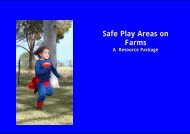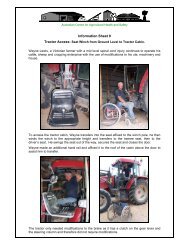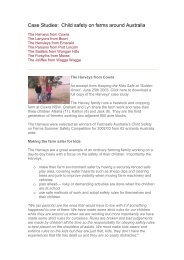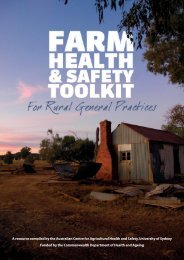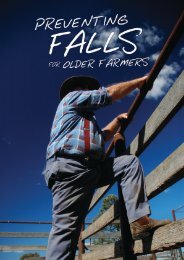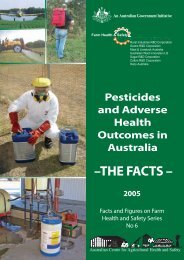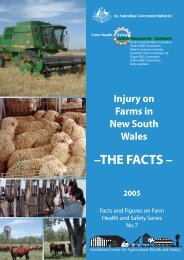Ripper ii Educational resource for primary schools - Australian ...
Ripper ii Educational resource for primary schools - Australian ...
Ripper ii Educational resource for primary schools - Australian ...
Create successful ePaper yourself
Turn your PDF publications into a flip-book with our unique Google optimized e-Paper software.
Tasks and Indicators Achieved Working towards Not YetLINKS TO THE PRIMARY CURRICULUMA summary of links to the most directly relevant curriculum outcomes <strong>for</strong> each state is provided, focusing on content-oriented outcomes withinthe Health and Physical Education (HPE) and Studies of Society and Environment (SOSE) curricula, as variously named across the states.These reflect an attempt to match goals <strong>for</strong> child injury prevention on farms with learning outcomes <strong>for</strong> safety in the context of investigatingfarms as places of natural and social significance. Activities also support literacy and communication outcomes <strong>for</strong> English; and Technologycurricula such as use of problem-solving, communication and thinking skills.This section refers to curriculum outcome statements <strong>for</strong> each state, accessed on-line and current as of April 2008. Alignment to nationallearning goals and standards are increasingly being articulated in state curricula documents as part of an ongoing curricula revision process.TermsKey learning areas (KLAs) are examples of curriculum organisers. They represent one of a number of ways of depicting the curriculum(or emphasis therein) to focus teaching and learning.The <strong>Australian</strong> Education Council (in 1991) adopted eight KLAs: English, Health and Physical Education, Languages other than English,Mathematics, Science, Studies of Society and Environment, Technology, and The Arts. The belief that these eight KLAs could effectivelyencapsulate the range of desirable learnings offered in <strong>schools</strong> Australia-wide was affirmed in the Adelaide Declaration (MCEETYA, 1999).Strands are groupings of the concepts in each of the eight KLAs.Levels, stages, bands or standards (as variously named) are points along the developmental continuum of student learning, listed in orderof increasing sophistication and complexity of learning outcomes.Learning outcomes (CLOs) or essential learnings are what students should know and be able to do as a result of planned learning experiences.Statements on essential learning outcomes, achievements or per<strong>for</strong>mance criteria (as variously named), are outcomes unique to a particularKLA in terms of the knowledges, practices and dispositions that should be developed by students who engage in that KLA.CD <strong>for</strong>mat – insertion of state-specific learning outcomesActivity sheets within each level of this <strong>resource</strong> have hyperlinks which enable teachers to click on the relevant curricular learningoutcomes <strong>for</strong> their state. These can be inserted onto activity sheets electronically prior to in-school reproduction of templates. These canbe used as a record to indicate that specified learning outcomes have been achieved. The following is an example of a state specific activitysheet with NSW Early Stage 1 (Level 1) PDHPE and HSIE learning outcomes inserted from curricular summaries of this <strong>resource</strong>.TOPIC 4: ANIMALS ON THE FARM (L1.AS4.1)Name: Class:Learning Outcomes: NSWIRES1.11 Identifies how individuals care <strong>for</strong> each other.SLES1.13 Demonstrates a developing awareness of the concepts of safe and unsafe living.SSES1 Identifies ways in which their own needs and the needs of others are met, individually and cooperatively.Identifies safe and unsafe places on a farmIdentifies animals found on farmsIdentifies safety rules when playing with animalsACTIVITY: 1. COMPARE THE PICTURES BELOW






